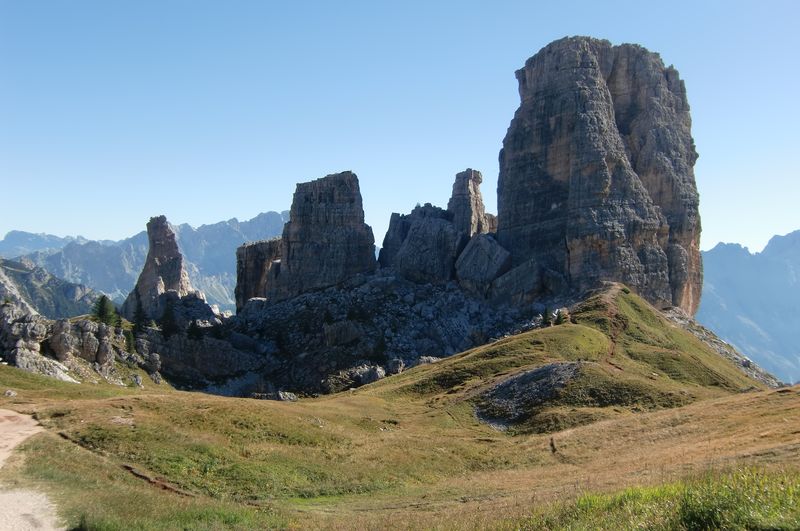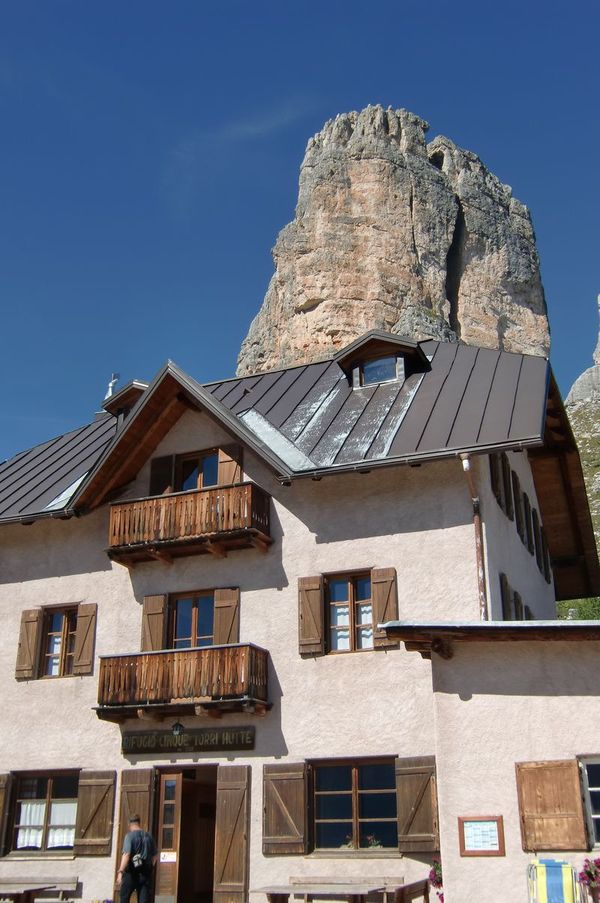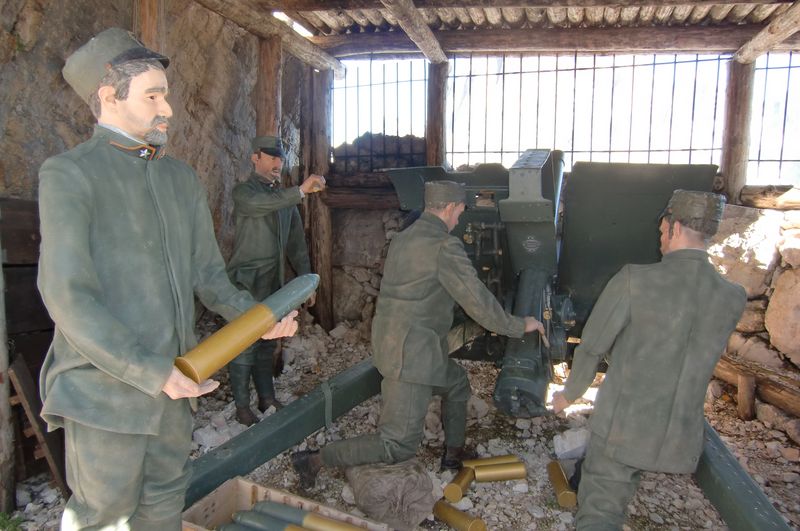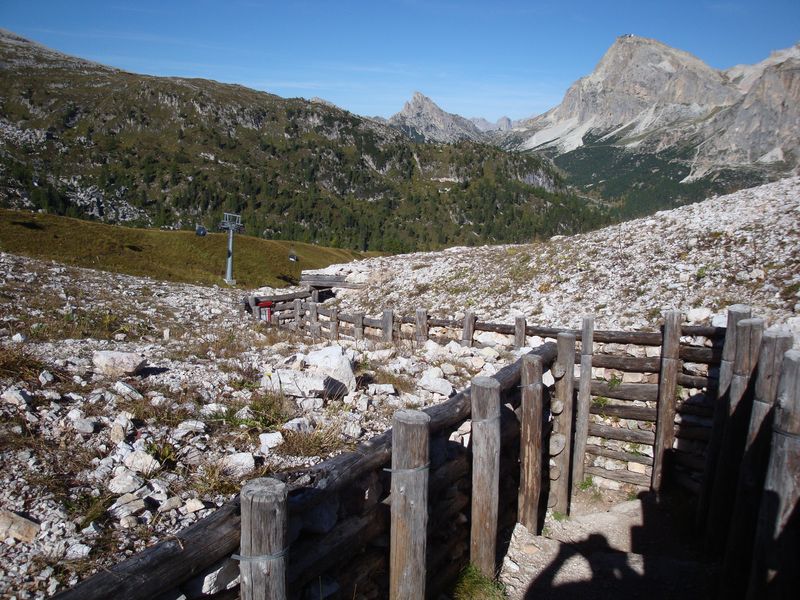 |
Regeländerung seit 10.06.2019
Nachzulesen hier.....
Als Ergänzung zu den Fragen wird ab sofort ein Foto von dir oder einem persönlichen Gegenstand wie z.B. deinem GPS o.ä. gefordert!
Logs ohne Foto das dich oder einen persönlichen Gegenstand von dir zeigen werden ohne weitere Nachfrage gelöscht!
Es genügt NICHT, das Foto mit den Antworten zu senden, das Foto gehört zum LOG hochgeladen!!!
|
|

Cinque Torri - das kleine Wunder in den Dolomiten
|
Cinque Torri - Die 5 Türme
Panorama von den Cinque Torri aus Richtung Norden zum Col de Bos

|
| Das charakteristische Gestein der Dolomiten besteht aus versteinerten Korallenriffen aus dem Trias-Zeitalter (vor etwa 250 Millionen Jahren). Diese Riffe wurden von Organismen und Sedimenten im tropischen Urmeer Tethys gebildet. Durch das Aufeinanderprallen der adriatischen und der eurasischen Platte wurde der gesamte Alpenraum in die Höhe geschoben, wodurch auch die Dolomiten zum Gebirge wurden.
Als Hauptdolomit bezeichnet man eine bis zu 2200 Meter mächtige lithostratigraphische Einheit in den nördlichen und südlichen Kalkalpen, in Teilen der westlichen und zentralen Ostalpen sowie im Apennin. Die Gesteine wurden großteils in flachen Lagunenbereichen in der Zeit des späten Karniums und des Noriums abgelagert. In den Südalpen bestehen unter anderem große Teile der Brenta, das obere Stockwerk der Sella oder die Drei Zinnen aus Hauptdolomit.
|
Interessant ist die unterschiedliche Ausprägung der Felsformationen. Es gibt Tafelberger zwischen denen sich ausgedehnte Hochflächen erstrecken. Im Kontrast dazu stehen die stark zerklüfteten Massive wie etwa Cinque Torri . Grund hierfür sind Gesteins-Partien, die vulkanischen Ursprungs sind. Diese verwittern leichter und lassen Zerklüftungen und abgerundete Ebenen entstehen. Genauso wurde der ursprünglich komplette Gesteinsblock der 5 Türme von der Natur gestaltet.
Der einzige heute noch existierende Gletscher der Dolomiten ist der Marmolatagletscher im der Provinz Belluno. |

|
|

|
Die Südtiroler Dolomiten nehmen im Bau der gesamten Alpen eine Sonderstellung ein. Während sonst überall typische alpine Tektonik herrscht mit Faltenstrukturen und Überschiebungen, oder gar ausgeprägter Deckentektonik, zeigen die Dolomiten wesentlich ruhigeren Bau. Im großen und ganzen liegt die Schichtenfolge normal vom kristallinen Untergrund bis hinauf zu den jüngsten erhaltenen Gesteinen.
Der Name der Dolomiten wie auch des Dolomitgesteins leitet sich von dem französischen Geologen Déodat de Dolomieu (1750-1801) ab, der als erster das charakteristische Gestein beschrieben hat. Davor war die Bezeichnung „Monti pallidi" - "bleiche Berge" verbreitet. Der eigentliche, von Dolomieu beschriebene "Dolomit" ist ein Mineral, ein Calcium Magnesium Carbonat, das zu unterschiedlichen Anteilen in den weißlich-grauen Kalksedimenten des Dolomiten-Gebirges enthalten ist. |
Am 26. Juni 2009 wurden Teile der Dolomiten durch die UNESCO als serielles Weltnaturerbe anerkannt.
Die Cinque Torri (deutsch: fünf Türme) sind eine bis zu 2.361 m hohe Felsformation in den Dolomiten an der Strecke zwischen dem Falzaregopass und Cortina d’Ampezzo.
Die Cinque Torri bestehen aus steilen Türmen. Sie waren einmal ein riesiger ganzer Felsblock. Die fünf Haupttürme, die Namensgeber, nennen sich Torre Grande, Torre Seconda, Torre Latina, Torre Quarta und Torre Inglese, wobei auch abweichende Benennungen verbreitet sind. Der Höchste ist der 2.361 m hohe Torre Grande, der neben dem Hauptgipfel Cima Nord auch noch die Nebentürme Cima Sud und Cima Ovest.
Anfang Juni 2004 ist eine schroffe, 50 m hohe Felsnadel namens Trephor aufgrund natürlicher Erosion zusammengebrochen. |
|

Trephor Felsnadel
|

Trephor Felsnadel
|
| Die Cinque Torri sind ein beliebtes Ziel von Wanderern und Kletterern und durch zahlreiche Routen ab dem III. Schwierigkeitsgrad erschlossen. In der Umgebung befinden sich mehrere Schutzhütten, darunter das nach den Türmen benannte Rifugio Cinque Torri (2.137 m) und das Rifugio Scoiattoli (2.255 m). |

|
Rund um die Cinque Torri gibt es auch ein Freilichtmuseum mit nachgebauten Schützenstellungen. Dieses erinnert an die Kampfhandlungen während des Ersten Weltkriegs unterhalb der Cinque Torri zwischen Österreich und Italien.
Während des Ersten Weltkriegs besetzte das italienische Heer das Gebiet Cinque Torri. Wegen der außergewöhnlich guten Sicht auf die nahen Berggruppen wurde hier der Kommandositz der italienischen Artillerie eingerichtet. Um die Felsmassen verteilte man eine Reihe von Kanonen gegen die österreichischen Posten am Lagazuoi und der Festung Tre Sassi. |
|

|

|
Logaufgabe
Schicke die Antworten auf die Fragen an meinen GC-Account und du bekommst die Logfreigabe.
1) Wann stürzte der Torre Trephor ein und warum?
2) Aus welchen Gesteinen bestehen die Dolomiten?
3) Wann entstanden die Dolomiten und woraus?
4) An der Südseite der Torri befindet sich eine Felsenkapelle. Wem ist diese gewidmet?
 |
Regeländerung seit 10.06.2019
Nachzulesen hier.....
Als Ergänzung zu den Fragen wird ab sofort ein Foto von dir oder einem persönlichen Gegenstand wie z.B. deinem GPS o.ä. gefordert!
Logs ohne Foto das dich oder einen persönlichen Gegenstand von dir zeigen werden ohne weitere Nachfrage gelöscht!
|
Viel Spaß beim Besuch dieser Location!
|
Cinque Torri - Five Towers
Panorama of the Cinque Torri from the north to the Col de Bos

|
| The typical rock of the Dolomites exists of fossilized coral reefs from the Trias age (before about 250 million years). These reefs were formed by organisms and sediments in the tropical old sea Tethys. The whole Alpine space was pushed by the clash of the adriatic ones and the Eurasian record upwards by which also the Dolomites became the mountains.
One calls Hauptdolomit a lithostratigraphische unity mighty up to 2200 metres in the northern and southern lime nightmares, in parts of the western and central east nightmares as well as in the Apennines. The rocks were deposited for the most part in level lagoon areas in the time of the late Karniums and the Noriums., Among the rest, in the south nightmares large parts of the Brenta, the upper floor of the Sella or Three merlons exist of Hauptdolomit.
|
The different stamping of the rock formations is interesting. There is Tafelberger between their vast high-level surfaces spread. In the contrast in addition stand the very cleft massifs as for example Cinque Torri. A reason for this are rock parts, the volcanic origin are. These weather lighter and let arise Zerklüftungen and rounded levels. Just the originally complete rock block of 5 towers was formed by the nature.
The only glacier existing even today of the Dolomites is of the Marmolatagletscher in of the province of Belluno. |

|
|

|
The South Tyrolean Dolomites take under construction of the whole Alps a special position. While, otherwise, everywhere typical alpine Tektonik it rules with pleated structures and Überschiebungen, or even of distinctive Deckentektonik, the Dolomites show substantially quieter construction. On the whole the layer result lies normally from the crystalline subsoil to up to the latest preserved rocks.
The name of the Dolomites as well as the Dolomitgesteins is derived from the French geologist Déodat de Dolomieu (in 1750-1801) who has described the typical rock as the first. Before it the name "Monti pallidi" - was "pale mountains" widespread. The real "Dolomit" described by Dolomieu is a mineral, a calcium magnesium Carbonat which is included to different shares in the whitish-grey lime sediments of the Dolomites mountains. |
On the 26th of June, 2009 parts of the Dolomites were recognised by UNESCO as a serial world nature heir.
The Cinque Torri (in German: five towers) are an up to 2.361-m-high rock formation in the Dolomites in the distance between the Falzaregopass and Cortina d'Ampezzo.
The Cinque Torri exist of precipitous pileworks. They were once a gigantic whole boulder. Five main towers, the name givers, are called Torre grandee, Torre Seconda, Torre Latina, Torre Quarta and Torre Inglese and also divergent namings are spread. The highest is the 2.361-m-high Torre grandee, beside the main summit Cima the north still the Nebentürme Cima broth and Cima Ovest.
At the beginning of June, 2004 a gruff, 50-m-high rock needle called Trephor has broken down on account of natural erosion. |
|

Trephor Needle
|

Trephor Needle
|
| The Cinque Torri are opened a popular aim by travellers and climbers and by numerous routes from the III degree of difficulty. In the surroundings are several protective huts, under it the Rifugio Cinque Torri named after the pileworks (2.137 m) and the Rifugio Scoiattoli (2.255 m). |

|
All around the Cinque Torri there is also an open-air museum with copied protection positions. This reminds of the fightings during the First World War below the Cinque Torri between Austria and Italy.
During the First World War the Italian army took the area Cinque of Torri. Because of the extremely good view of the close mountain groups the command seat of the Italian artillery was furnished here. Around the rock masses one distributed a row of cannons against the Austrian posts in the Lagazuoi and the fortress Tre Sassi. |
|

|

|
Log job
Send the answers to those questions to my GC account and you get the permission to log.
1) When broke the "Torre Trephor" and why?
2) From which rocks are the Dolomites?
3) When where the Dolomites made?
4) On the Southside of the Torri is a Chapel. For which people is she made?
 |
Rule change since 10.06.2019
Read more.....
As a supplement to the questions, a photo of you or of a personal item such as your GPS or similar required!
Logs without a photo showing you or a personal item will be deleted without further request!
|
A lot of fun in the visit of this Location!
|
Cinque Torri
Panorama delle Cinque Torri dal nord al Col de Bos
|
|
La roccia caratteristica delle Dolomiti è costituito da barriere coralline fossili del periodo Triassico (circa 250 milioni di anni fa). Queste scogliere sono formate da organismi marini e di antichi sedimenti nella Tetide tropicale. Dalla collisione del mare Adriatico e la placca euroasiatica, l'intera regione alpina è stato spinto verso l'alto, per cui le Dolomiti, le montagne erano.
Dolomite come quella principale si chiama fino a 2200 m di spessore unità litostratigrafiche del Nord e del Sud Alpi calcaree, nella parte occidentale e centrale delle Alpi orientali e l'Appennino. Le rocce sono state in gran parte depositati in aree lagunari poco profondi, nel periodo del tardo Carniche e Noriums. Le Alpi meridionali sono tra le altre parti principali del Brenta, al piano superiore della sella o le Tre Cime di Dolomiti principale.
|
È interessante notare che l'espressione di diverse formazioni rocciose. Ci sono tra le mesas che si estendono estesi altipiani. In contrasto con questa sono massicci estremamente frastagliata, come le Cinque Torri. Ciò è dovuto a un sacco di roccia di origine vulcanica. Queste tempo e può sviluppare facilmente fessure e piani arrotondati. Basta compilare il blocco originale in pietra delle 5 torri sono stati progettati dalla natura.
L'unico ancora esistente ghiacciai delle Dolomiti è la Marmolatagletscher in provincia di Belluno. |

|
|

|
Le Dolomiti prendere uno per la costruzione di tutto l'arco alpino, una posizione speciale. Mentre tutto il resto tipicamente alpino con le strutture tettoniche prevale piega e sovrascorrimenti, o Deckentektonik ancora più pronunciato mostrando Dolomiti molto più silenzioso di costruzione. In linea di massima, la sequenza di strati è normalmente dal substrato cristallino fino ai più piccoli scogli conservati.
Il nome delle Dolomiti così come la roccia dolomitica deriva dal geologo francese Deodat de Dolomieu (1750-1801) da quello descritto per primo la roccia caratteristica. In precedenza è stato chiamato "Monti Pallidi" -. "Monti Pallidi", la diffusione attuale, come descritto da Dolomieu "dolomite" è un minerale, un carbonato di calcio e magnesio, che è incluso in proporzioni variabili in bianco-grigio sedimenti calcarei delle Dolomiti. |
Il 26 Giugno 2009 sono state accettate le parti delle Dolomiti dall'UNESCO come sito seriale Patrimonio Mondiale dell'Umanità.
Le Cinque Torri (in tedesco: cinque torri) sono uno dei fino a 2.361 m di altezza formazione rocciosa delle Dolomiti nella distanza tra il Falzaregopass e Cortina d'Ampezzo.
Le Cinque Torri costituiti da torri ripide. Se un tempo eravate un gigante di roccia intero. Le cinque torri principali, i nomi dei donatori, si definiscono Torre Grande, Seconda Torre, Torre Latina, Quarta Torre e Torre Inglese, che sono anche molto differenti denominazioni. La più alta è l'alta 2.361 m Torre Grande, vicino alla vetta principale della Cima anche il lato Nord e Sud torri Cima Cima Ovest.
Ai primi di giugno 2004 è un robusto, è crollato a 50 m di roccia ad alta pinnacolo chiamato Trephor a causa dell'erosione naturale. |
|

Trephor pinnacolo
|

Trephor pinnacolo
|
| Le Cinque Torri sono una destinazione popolare per gli escursionisti e alpinisti e attraverso numerosi percorsi dal III. Difficoltà sviluppati. Nelle vicinanze sono rifugi diversi, tra cui uno intitolato al Rifugio Torri Cinque Torri (2137 m) e il Rifugio Scoiattoli (2255 m). |

|
Intorno le Cinque Torri, c'è anche un museo a cielo aperto, con posizioni di tiro ricostruito. Questo ricorda gli scontri durante la prima guerra mondiale sotto le Cinque Torri tra Austria e Italia.
Durante la prima guerra mondiale, l'esercito italiano occupò il territorio delle Cinque Torri. A causa della vista eccezionale delle catene montuose vicine qui dalla sede del comando dell'artiglieria italiana è stata costituita. Per la massa rocciosa è distribuito una serie di cannoni contro le postazioni austriache sul Lagazuoi e il Forte Tre Sassi. |
|

|

|
Invia le risposte alle domande sul mio conto GC e si può ottenere il Logfreigabe.
1) Quando il crollo Torre Trephor e perché?
2) Da cui rocce sono le Dolomiti?
3) Quando sono stati risultante tra le Dolomiti e il?
4) Sul lato sud di Torri è una rock band. A chi è dedicato a questo?
Opzionalmente, è possibile inviare foto come il registro!
Log job
Send the answers to those questions to my GC account and you get the permission to log.
1) When broke the "Torre Trephor" and why?
2) From which rocks are the Dolomites?
3) When where the Dolomites made?
4) On the Southside of the Torri is a Chapel. For which people is she made?
 |
Rule change since 10.06.2019
Read more.....
As a supplement to the questions, a photo of you or of a personal item such as your GPS or similar required!
Logs without a photo showing you or a personal item will be deleted without further request!
|
A lot of fun in the visit of this Location!